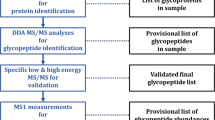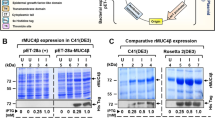Abstract
The Epithelial Membrane Antigen (EMA) has until now only been described in immunological terms and has been shown immunohistochemically to be present on a variety of human non-squamous epithelial surfaces. It is a valuable marker in diagnostic tumour pathology and enables the detection of small deposits of malignant cells in organs such as liver and bone marrow. Its discovery in soluble form in human milk has enabled a purification of the antigen from this source. The antigenic activity in the milk is spread over a wide range of mol. wts and although purification causes a general reduction in size, the antigen remains heterogeneous. Carbohydrate forms the major component of the antigen with galactose and N-acetylglucosamine as the two major sugars. The protein content of EMA is low and shows considerable variation in amino acid composition from one sample to another. A high content of inorganic material has also been found in EMA but is not due to high sulphate or phosphate levels.
This is a preview of subscription content, access via your institution
Access options
Subscribe to this journal
Receive 24 print issues and online access
$259.00 per year
only $10.79 per issue
Buy this article
- Purchase on Springer Link
- Instant access to full article PDF
Prices may be subject to local taxes which are calculated during checkout
Similar content being viewed by others
Rights and permissions
About this article
Cite this article
Ormerod, M., Steele, K., Westwood, J. et al. Epithelial membrane antigen: Partial purification, assay and properties. Br J Cancer 48, 533–541 (1983). https://doi.org/10.1038/bjc.1983.226
Issue Date:
DOI: https://doi.org/10.1038/bjc.1983.226
This article is cited by
-
Characterization of normal breast epithelial cells in primary cultures: Differentiation and growth factor receptors studies
In Vitro Cellular & Developmental Biology - Animal (1992)
-
Inhibition of the hepatocyte uptake of radiolabelled monoclonal antibodies by chelating agents
European Journal of Nuclear Medicine (1990)
-
Structures of acidic O-linked polylactosaminoglycans on human skim milk mucins
Glycoconjugate Journal (1990)
-
Monoclonal antibodies reactive with mucin expressed in breast cancer
Immunology & Cell Biology (1989)
-
Comparison of monoclonal antibodies for the detection of occult breast carcinoma metastases in bone marrow
Breast Cancer Research and Treatment (1988)



